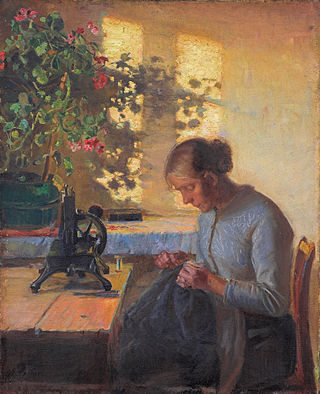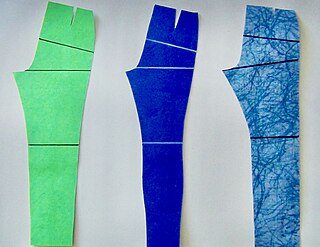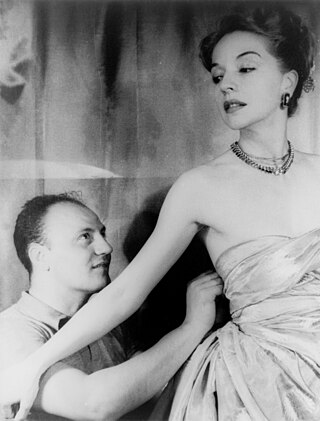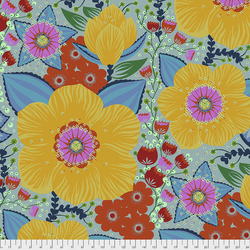
Sewing is the craft of fastening or attaching objects using stitches made with a sewing needle and thread. Sewing is one of the oldest of the textile arts, arising in the Paleolithic era. Before the invention of spinning yarn or weaving fabric, archaeologists believe Stone Age people across Europe and Asia sewed fur and leather clothing using bone, antler or ivory sewing-needles and "thread" made of various animal body parts including sinew, catgut, and veins.

A hem in sewing is a garment finishing method, where the edge of a piece of cloth is folded and sewn to prevent unravelling of the fabric and to adjust the length of the piece in garments, such as at the end of the sleeve or the bottom of the garment.

In sewing and fashion design, a pattern is the template from which the parts of a garment are traced onto woven or knitted fabrics before being cut out and assembled. Patterns are usually made of paper, and are sometimes made of sturdier materials like paperboard or cardboard if they need to be more robust to withstand repeated use. The process of making or cutting patterns is sometimes compounded to the one-word Patternmaking, but it can also be written pattern(-)making or pattern cutting.

Elie Saab is a Lebanese fashion designer.

Nicole Miller is an American fashion designer and businesswoman.

Zardozi or zar-douzi or zarduzi, is an Iranian, Indian-subcontinent and Central Asian embroidery type. Zardozi comes from two Persian words: zar or zarin meaning 'gold', and dozi meaning 'sewing'. Zardozi is a type of heavy and elaborate metal embroidery on a silk, satin, or velvet fabric base. Designs are often created using gold and silver threads and can incorporate pearls, beads, and precious stones. It is used as decoration for a wide range of applications, including clothes, household textiles, and animal trappings. Historically, it was used to adorn the walls of royal tents, scabbards, wall hangings and the paraphernalia of regal elephants and horses.
Nancy L. Zieman was an American author and designer widely known as the host of the television show Sewing with Nancy.

Fashion design is the art of applying design, aesthetics, clothing construction and natural beauty to clothing and its accessories. It is influenced by culture and different trends, and has varied over time and place. "A fashion designer creates clothing, including dresses, suits, pants, and skirts, and accessories like shoes and handbags, for consumers. He or she can specialize in clothing, accessory, or jewelry design, or may work in more than one of these areas."

Sew Fast Sew Easy was a corporation based in the Garment District in New York City, that is best known for sewing classes, sewing patterns and sewing books. It was founded in 1991 by Elissa K. Meyrich, a designer in New York City's garment district for over 26 years, an instructor at Parsons School of Design, and an author and contributing writer to sewing publications. Sew Fast Sew Easy classes were part of a resurgence in traditional home economics enabled by networked technologies including Internet chat groups and digitally-adjustable patterns. The company created NYC's first Stitch and Bitch group in 1997. The company started an Internet guestbook, the Stitch and Bitch Cafe, in 1998.

Haute couture is the creation of exclusive custom-fitted high-end fashion design that is constructed by hand from start-to-finish. Beginning in the mid-nineteenth century, Paris became the centre of a growing industry that focused on making outfits from high-quality, expensive, often unusual fabric and sewn with extreme attention to detail and finished by the most experienced and capable of sewers—often using time-consuming, hand-executed techniques. Couture translates literally from French as "dressmaking", sewing, or needlework and is also used as a common abbreviation of haute couture and can often refer to the same thing in spirit. Haute translates literally to "high".
Sewing is the craft of fastening or attaching objects using stitches made with needle and thread. Sewing is one of the oldest of the textile arts, arising in the Paleolithic Era. Although usually associated with clothing and household linens, sewing is used in a variety of crafts and industries, including shoemaking, upholstery, sailmaking, bookbinding and the manufacturing of some kinds of sporting goods. Sewing is the fundamental process underlying a variety of textile arts and crafts, including embroidery, tapestry, quilting, appliqué and patchwork.

In sewing and tailoring, a lining is an inner layer of fabric, fur, or other material inserted into clothing, hats, luggage, curtains, handbags and similar items.
A zigzag stitch is variant geometry of the lockstitch. It is a back-and-forth stitch used where a straight stitch will not suffice, such as in reinforcing buttonholes, in stitching stretchable fabrics, and in temporarily joining two work pieces edge-to-edge.

In sewing and tailoring, facing is a small piece of fabric, separate or a part of the garment fabric itself, used to finish the fabric edges. This is distinguished from hemming which simply folds the edge over; facing is a more substantial layer of additional fabric added to the edges of the garment. The facing adds addition support, strength and prevents stretching. Facing makes a garment look professionally finished with the seams well hidden inside the folds of the facing. Facing is mostly used to finish the edges in necklines, armholes, hems and openings. They are also used widely in all other sewing like quilts and home decor items like curtain hems.

A blind stitch in sewing is a method of joining two pieces of fabric so that the stitch thread is invisible, or nearly invisible. Blind stitching hides stitching under folded edges; therefore, this type of stitch can be used to create a blind hem or to join two folded edges together.
Antthony Mark Hankins is an American fashion designer who founded Antthony Mark Hankins Inc. in 1994. By his mid-twenties he had built his own $40 million business and was named by Newsweek as one of the top 100 people to watch in America.

Michael Donnellan (1915–1985) – best known as Michael of Carlos Place and simply Michael – was an Irish-born fashion designer who headed the house of Lachasse from 1941, before running a successful eponymous couture house in London from 1953 to 1971. From the 1960s on, he combined the role of couturier with consultancy to mainstream fashion houses, most notably acting as a key consultant to Marks & Spencer.
Matilda Rose "Tilly" Walnes is an English fashion designer, author and educator. Based in South London, she designs plain language sewing patterns and hosts online workshops.
Jen Beeman is an American fashion designer and patternmaker based in Chicago, Illinois. She is best known as the owner of the sewing pattern company and blog Grainline Studio. She is a graduate of Columbia College where she studied fashion design with a focus on pattern making and technical design.

Anna Maria Horner is an artist, author and fabric designer in Nashville, Tennessee, known for her colorful fabric designs, quilts, and sewing patterns. In addition to teaching classes and selling items globally under her namesake brand, she has written several books about sewing, quilting, and needlework. Horner has appeared on The Martha Stewart Show and been featured in Better Homes and Gardens. In May 2015 she opened Craft South, a craft store and studio in Nashville.














